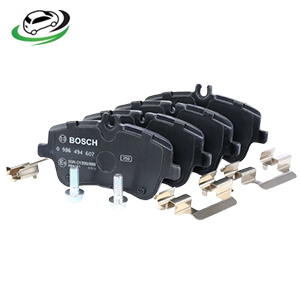-3%
Get Front Brake Pad Kit AUDI A3/ A1-Sportback/ Hatchback MBP0392
Brake pads are a critical component of a vehicle’s braking system, responsible for converting the kinetic energy of the moving vehicle into thermal energy through friction, thereby slowing or stopping the vehicle. Understanding the benefits of brake pads and recognizing signs indicating the need for replacement is essential for ensuring safe driving conditions and optimal braking performance.
Benefits of Brake Pads:
- Efficient Braking Performance: Brake pads are designed to provide consistent and reliable braking performance under various driving conditions. They generate the necessary friction to slow down or stop the vehicle quickly and effectively when the brake pedal is applied.
- Heat Dissipation: High-quality brake pads are engineered to withstand the heat generated during braking and dissipate it efficiently. Proper heat dissipation helps prevent brake fade, which occurs when the braking performance deteriorates due to overheating of the brake components.
- Smooth Operation: Well-maintained brake pads contribute to smooth and predictable braking operation, allowing the driver to modulate braking force accurately. This enhances driving comfort and control, especially during emergency braking or maneuvers.
- Reduced Noise and Vibration: Brake pads equipped with noise-dampening features help minimize squealing or squeaking noises during braking. Additionally, they reduce vibration and brake judder, enhancing overall driving comfort and reducing cabin noise levels.
- Longevity: High-quality brake pads are designed to withstand significant wear and provide extended service life. They undergo rigorous testing to ensure durability and performance, reducing the frequency of replacement intervals and associated maintenance costs.
- Compatibility: Brake pads are available in various formulations and designs to suit different vehicle models and driving preferences. Whether for everyday commuting or high-performance driving, there are brake pad options tailored to specific needs and requirements.
- Safety: Perhaps the most crucial benefit of brake pads is their role in ensuring vehicle safety. Properly functioning brake pads are essential for stopping the vehicle promptly and effectively, helping prevent accidents and collisions on the road.
Signs a Car Needs New Brake Pads:
- Squealing or Grinding Noise: One of the most common signs of worn brake pads is a squealing or grinding noise when braking. This noise is typically caused by the wear indicators on the brake pads, which are designed to produce audible alerts when the pads are nearing the end of their service life.
- Reduced Brake Performance: If you notice a decrease in braking effectiveness or longer stopping distances, it may indicate worn brake pads. As the brake pads wear down, there is less material available to generate friction, leading to diminished braking performance.
- Vibration or Pulsation: Experiencing vibrations or pulsations through the brake pedal or steering wheel during braking could signal issues with the brake pads or other brake components. This may indicate uneven wear or warped brake rotors, necessitating inspection and potential replacement of the brake pads.
- Visible Wear: Inspecting the brake pads visually can provide valuable information about their condition. If the brake pads appear excessively worn, thin, or unevenly worn, they should be replaced promptly to maintain optimal braking performance and safety.
- Dashboard Warning Light: Some modern vehicles are equipped with brake pad wear sensors that trigger a dashboard warning light when the brake pads are worn beyond a certain threshold. If the brake pad warning light illuminates, it’s essential to have the brake pads inspected and replaced as needed.
- Burning Smell: A burning or unusual odor coming from the wheels after braking could indicate overheating of the brake pads due to excessive friction. This may result from prolonged braking or aggressive driving and should be addressed promptly to prevent damage to the braking system.
- Visible Damage or Corrosion: Physical damage or corrosion on the surface of the brake pads can compromise their effectiveness and lead to accelerated wear. Inspecting the brake pads during routine maintenance or tire changes can help identify any signs of damage or corrosion that warrant replacement.
Follow us on Facebook For more parts.



